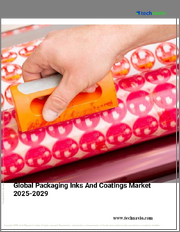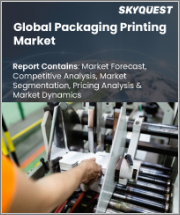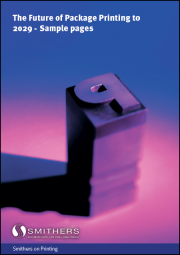
|
시장보고서
상품코드
1575240
3D 프린팅 포장 시장 규모, 점유율 및 동향 분석 보고서 : 재료별, 기술별, 용도별, 지역별, 부문별 예측(2024-2030년)3D Printed Packaging Market Size, Share & Trends Analysis Report By Material (Plastics, Paper & Paperboard, Aluminum), By Technology, By Application, By Region, And Segment Forecasts, 2024 - 2030 |
||||||
3D 프린팅 포장 시장 규모와 동향 :
세계 3D 프린팅 포장 시장 규모는 2023년 12억 5,000만 달러로 추정되며, 2024년부터 2030년까지 연평균 5.5%의 성장률을 보일 것으로 예상됩니다.
이 시장은 맞춤화의 필요성, 지속가능성에 대한 노력, 부가가치 제조 기술의 발전 등 여러 가지 촉진요인에 의해 성장하고 있습니다. 주요 촉진요인 중 하나는 개인화된 패키징 솔루션에 대한 수요가 증가하고 있다는 점입니다. 브랜드는 경쟁이 치열한 시장에서 눈에 띄는 방법을 찾고 있으며, 3D 프린팅은 소비자 경험을 향상시키는 맞춤형 패키징을 설계하고 제조할 수 있는 유연성을 제공합니다. 예를 들어, 고급 브랜드는 종종 3D 프린팅을 사용하여 개별 고객에 맞는 복잡한 맞춤형 패키징 디자인을 만들어 특별함과 개인화된 느낌을 만들어냅니다.
지속가능성은 3D 프린팅 포장 시장을 촉진하는 또 다른 중요한 요인입니다. 기업들이 탄소 발자국을 줄이기 위해 노력하는 가운데, 3D 프린팅은 포장 제조에서 폐기물을 줄일 수 있는 효율적인 방법을 제공합니다. 기존 제조 방식은 재료 낭비를 초래하는 경우가 많지만, 3D 프린팅은 필요한 만큼의 재료만 사용하기 때문에 세계 지속가능성 목표에 부합합니다. 또한, 생분해성 및 재활용이 가능한 3D 프린팅 재료의 발전은 포장재에 대한 이 기술의 채택을 더욱 촉진하고 있습니다.
적층 가공의 기술 발전도 3D 프린팅 포장의 성장에 중요한 역할을 하고 있습니다. 더 빠르고 정밀한 3D 프린터의 개발로 대량 맞춤화와 생산주기 단축이 가능해졌습니다. 이는 식음료와 같이 포장을 신속하고 대량으로 생산해야 하는 산업에서 특히 유용합니다. 예를 들어, 코카콜라는 3D 프린팅 기술을 사용하여 한정판 병을 제작하여 디자인의 유연성을 유지하면서 대규모 생산을 지원할 수 있음을 보여주었습니다.
또한, 가볍고 내구성이 뛰어난 패키징을 생산할 수 있기 때문에 전자상거래, 물류 등의 산업에서도 3D 프린팅을 도입하고 있습니다. 경량 포장은 운송 비용과 이산화탄소 배출량을 줄이고, 내구성이 뛰어난 소재는 운송 중 제품 보호를 보장합니다. 이러한 비용 절감, 지속가능성 및 제품 안전의 조합은 특히 효율적이고 지속 가능한 물류 솔루션에 대한 수요가 높은 시장에서 기업들이 3D 프린팅 포장 솔루션을 고려하도록 유도하고 있습니다.
목차
제1장 조사 방법과 범위
제2장 주요 요약
제3장 3D 프린팅 포장 시장 변수, 동향, 범위
- 시장 계통 전망
- 침투와 성장 전망 매핑
- 업계 밸류체인 분석
- 원재료 동향
- 제조업 동향
- 규제 프레임워크
- 시장 역학
- 시장 성장 촉진요인 분석
- 시장 성장 억제요인 분석
- 시장이 해결해야 할 과제 분석
- 비즈니스 환경 분석
- 업계 분석 - Porter의 Five Forces 분석
- PESTEL 분석
- 환경, 사회, 거버넌스(ESG) 구상이 3D 프린팅 패키지 시장에 미치는 영향
제4장 3D 프린팅 포장 시장 : 재료 추정·동향 분석
- 정의와 범위
- 물질 변동 분석과 시장 점유율, 2023년과 2030년
- 플라스틱
- 종이 및 판지
- 알루미늄
- 기타 자료
제5장 3D 프린팅 포장 시장 : 기술 추정·동향 분석
- 정의와 범위
- 기술 변동 분석과 시장 점유율, 2023년과 2030년
- Stereolithography (SLA)
- Selective Laser Sintering (SLS)
- Digital Light Processing (DLP)
- Multi Jet Fusion (MJF)
- Electron Beam Melting (EBM)
- Direct Metal Laser Sintering (DMLS)
- Binder Jetting
- Laminated Object Manufacturing (LOM)
제6장 3D 프린팅 포장 시장 : 용도 추정·동향 분석
- 정의와 범위
- 용도 변동 분석과 시장 점유율, 2023년과 2030년
- 식품 및 음료
- 화장품
- 제약
- 소비재
- 산업 제품
- 일렉트로닉스
- 기타
제7장 3D 프린팅 포장 시장 : 지역 추정·동향 분석
- 중요 포인트
- 지역 변동 분석과 시장 점유율, 2023년과 2030년
- 북미
- 재료별, 2018년-2030년
- 기술별, 2018년-2030년
- 용도별, 2018년-2030년
- 미국
- 캐나다
- 멕시코
- 유럽
- 재료별, 2018년-2030년
- 기술별, 2018년-2030년
- 용도별, 2018년-2030년
- 독일
- 영국
- 프랑스
- 이탈리아
- 스페인
- 아시아태평양
- 재료별, 2018년-2030년
- 기술별, 2018년-2030년
- 용도별, 2018년-2030년
- 중국
- 인도
- 일본
- 중남미
- 재료별, 2018년-2030년
- 기술별, 2018년-2030년
- 용도별, 2018년-2030년
- 브라질
- 아르헨티나
- 중동 및 아프리카
- 재료별, 2018년-2030년
- 기술별, 2018년-2030년
- 용도별, 2018년-2030년
- 사우디아라비아
- 아랍에미리트(UAE)
- 남아프리카공화국
제8장 경쟁 구도
- 주요 기업과 최근 동향, 그리고 업계에 대한 영향
- 벤더 구도
- 주요 기업/경쟁 분류
- 주요 원재료 판매업체 및 채널 파트너 리스트
- 기업의 시장 포지셔닝 분석, 2023년
- 기업 히트맵 분석
- 전략 매핑
- 확장
- 협업/파트너십/계약
- 신제품 발매
- 인수합병(M&A)
- 기타
- 시장 대시보드 분석
제9장 기업 리스트/개요
- Stratasys Ltd.
- 기업 개요
- 재무 실적
- .제품 벤치마킹
- 3D Systems Corporation
- Materialise NV
- EOS GmbH
- Arcam AB
- SLM Solutions Group AG
- Nexa3D
- Protolabs Inc.
- GE Additive
- Carbon, Inc.
- Desktop Metal, Inc.
- Formlabs, Inc.
- Xometry, Inc.
- CELLINK AB
- Markforged, Inc.
제10장 전략적 추천 사항/애널리스트의 견해
LSH 24.11.053D Printed Packaging Market Size & Trends:
The global 3D printed packaging market size was estimated at USD 1.25 billion in 2023 and is expected to grow at a CAGR of 5.5% from 2024 to 2030. The market is experiencing growth due to several driving factors, including the need for customization, sustainability initiatives, and advancements in additive manufacturing technologies. One of the primary drivers is the increasing demand for personalized packaging solutions. Brands are looking for ways to stand out in a competitive market, and 3D printing offers them the flexibility to design and produce customized packaging that enhances the consumer experience. For instance, luxury brands often use 3D printing to create intricate, bespoke packaging designs that are tailored to individual customers, creating a sense of exclusivity and personalization.
Sustainability is another critical factor driving the 3D-printed packaging market. As businesses aim to reduce their carbon footprint, 3D printing provides an efficient method to reduce waste in packaging production. Traditional manufacturing methods often involve material wastage, but 3D printing uses only the necessary amount of material, which aligns with global sustainability goals. Moreover, advancements in biodegradable and recyclable 3D printing materials are further pushing the adoption of this technology in packaging.
Technological advancements in additive manufacturing are also playing a significant role in the growth of 3D-printed packaging. The development of faster and more precise 3D printers allows for mass customization and shorter production cycles. This is particularly beneficial in industries like food and beverage, where packaging needs to be produced quickly and in large quantities. For example, Coca-Cola has used 3D printing technology to create limited-edition bottles, showcasing how the technology can support large-scale production while maintaining design flexibility.
Additionally, the ability to produce lightweight and durable packaging is driving the adoption of 3D printing in industries such as e-commerce and logistics. Lightweight packaging reduces shipping costs and carbon emissions, while durable materials ensure product protection during transportation. This combination of cost savings, sustainability, and product security is encouraging companies to explore 3D-printed packaging solutions, particularly in markets with high demand for efficient and sustainable logistics solutions.
Global 3D Printed Packaging Market Report Segmentation
This report forecasts revenue growth at global, regional, and country levels and provides an analysis of the latest industry trends in each of the sub-segments from 2018 to 2030. For this study, Grand View Research has segmented the global 3D printed packaging market report on the basis of material, technology, application, and region:
- Material Outlook (Volume, Kilotons; Revenue, USD Million, 2018 - 2030)
- Plastics
- Paper & Paperboard
- Aluminum
- Others
- Technology Outlook (Volume, Kilotons; Revenue, USD Million, 2018 - 2030)
- Fused Deposition Modeling (FDM)
- Stereolithography (SLA)
- Selective Laser Sintering (SLS)
- Digital Light Processing (DLP)
- Multi Jet Fusion (MJF)
- Electron Beam Melting (EBM)
- Direct Metal Laser Sintering (DMLS)
- Binder Jetting
- Laminated Object Manufacturing (LOM)
- Application Outlook (Volume, Kilotons; Revenue, USD Million, 2018 - 2030)
- Food & Beverage
- Cosmetics
- Pharmaceutical
- Consumer Goods
- Industrial Goods
- Electronics
- Others
- Regional Outlook (Volume, Kilotons; Revenue, USD Million, 2018 - 2030)
- North America
- U.S.
- Canada
- Mexico
- Europe
- Germany
- UK
- France
- Italy
- Spain
- Asia Pacific
- China
- India
- Japan
- Central & South America
- Brazil
- Argentina
- Middle East & Africa
- Saudi Arabia
- UAE
- South Africa
Table of Contents
Chapter 1. Methodology and Scope
- 1.1. Market Segmentation & Scope
- 1.2. Market Definition
- 1.3. Information Procurement
- 1.3.1. Purchased Database
- 1.3.2. GVR's Internal Database
- 1.3.3. Secondary Materials & Third-Party Perspectives
- 1.3.4. Primary Research
- 1.4. Information Analysis
- 1.4.1. Data Analysis Models
- 1.5. Market Formulation & Data Visualization
- 1.6. Data Validation & Publishing
- 1.7. List of Abbreviations
Chapter 2. Executive Summary
- 2.1. Market Outlook, 2023 (USD Million)
- 2.2. Segmental Outlook
- 2.3. Competitive Landscape Snapshot
Chapter 3. 3D Printed Packaging Market Variables, Trends, and Scope
- 3.1. Market Lineage Outlook
- 3.2. Penetration and Growth Prospect Mapping
- 3.3. Industry Value Chain Analysis
- 3.3.1. Raw Material Trends
- 3.3.2. Manufacturing Trends
- 3.4. Regulatory Framework
- 3.5. Market Dynamics
- 3.5.1. Market Driver Analysis
- 3.5.2. Market Restraint Analysis
- 3.5.3. Market Challenges Analysis
- 3.6. Business Environment Analysis
- 3.6.1. Industry Analysis - Porter's
- 3.6.2. PESTEL Analysis
- 3.7. Impact of Environmental, Social, and Governance (ESG) initiatives on the 3D Printed Packaging Market
Chapter 4. 3D Printed Packaging Market: Material Estimates & Trend Analysis
- 4.1. Definition & Scope
- 4.2. Material Movement Analysis & Market Share, 2023 & 2030
- 4.3. Plastics
- 4.3.1. Market estimates and forecasts, 2018 - 2030 (USD Million) (Kilotons)
- 4.4. Paper & Paperboard
- 4.4.1. Market estimates and forecasts, 2018 - 2030 (USD Million) (Kilotons)
- 4.5. Aluminum
- 4.5.1. Market estimates and forecasts, 2018 - 2030 (USD Million) (Kilotons)
- 4.6. Other Materials
- 4.6.1. Market estimates and forecasts, 2018 - 2030 (USD Million) (Kilotons)
Chapter 5. 3D Printed Packaging Market: Technology Estimates & Trend Analysis
- 5.1. Definition & Scope
- 5.2. Technology Movement Analysis & Market Share, 2023 & 2030
- 5.3. Fused Deposition Modeling (FDM)
- 5.3.1. Market estimates and forecasts, 2018 - 2030 (USD Million) (Kilotons)
- 5.4. Stereolithography (SLA)
- 5.4.1. Market estimates and forecasts, 2018 - 2030 (USD Million) (Kilotons)
- 5.5. Selective Laser Sintering (SLS)
- 5.5.1. Market estimates and forecasts, 2018 - 2030 (USD Million) (Kilotons)
- 5.6. Digital Light Processing (DLP)
- 5.6.1. Market estimates and forecasts, 2018 - 2030 (USD Million) (Kilotons)
- 5.7. Multi Jet Fusion (MJF)
- 5.7.1. Market estimates and forecasts, 2018 - 2030 (USD Million) (Kilotons)
- 5.8. Electron Beam Melting (EBM)
- 5.8.1. Market estimates and forecasts, 2018 - 2030 (USD Million) (Kilotons)
- 5.9. Direct Metal Laser Sintering (DMLS)
- 5.9.1. Market estimates and forecasts, 2018 - 2030 (USD Million) (Kilotons)
- 5.10. Binder Jetting
- 5.10.1. Market estimates and forecasts, 2018 - 2030 (USD Million) (Kilotons)
- 5.11. Laminated Object Manufacturing (LOM)
- 5.11.1. Market estimates and forecasts, 2018 - 2030 (USD Million) (Kilotons)
Chapter 6. 3D Printed Packaging Market: Application Estimates & Trend Analysis
- 6.1. Definition & Scope
- 6.2. Application Movement Analysis & Market Share, 2023 & 2030
- 6.3. Food & Beverage
- 6.3.1. Market estimates and forecasts, 2018 - 2030 (USD Million) (Kilotons)
- 6.4. Cosmetics
- 6.4.1. Market estimates and forecasts, 2018 - 2030 (USD Million) (Kilotons)
- 6.5. Pharmaceutical
- 6.5.1. Market estimates and forecasts, 2018 - 2030 (USD Million) (Kilotons)
- 6.6. Consumer Goods
- 6.6.1. Market estimates and forecasts, 2018 - 2030 (USD Million) (Kilotons)
- 6.7. Industrial Goods
- 6.7.1. Market estimates and forecasts, 2018 - 2030 (USD Million) (Kilotons)
- 6.8. Electronics
- 6.8.1. Market estimates and forecasts, 2018 - 2030 (USD Million) (Kilotons)
- 6.9. Others
- 6.9.1. Market estimates and forecasts, 2018 - 2030 (USD Million) (Kilotons)
Chapter 7. 3D Printed Packaging Market: Regional Estimates & Trend Analysis
- 7.1. Key Takeaways
- 7.2. Regional Movement Analysis & Market Share, 2023 & 2030
- 7.3. North America
- 7.3.1. market estimates and forecasts, 2018 - 2030 (USD Million) (Kilotons)
- 7.3.2. market estimates and forecasts, by material, 2018 - 2030 (USD Million) (Kilotons)
- 7.3.3. market estimates and forecasts, by technology, 2018 - 2030 (USD Million) (Kilotons)
- 7.3.4. market estimates and forecasts, by application, 2018 - 2030 (USD Million) (Kilotons)
- 7.3.5. U.S.
- 7.3.5.1. market estimates and forecasts, 2018 - 2030 (USD Million) (Kilotons)
- 7.3.5.2. market estimates and forecasts, by material, 2018 - 2030 (USD Million) (Kilotons)
- 7.3.5.3. market estimates and forecasts, by technology, 2018 - 2030 (USD Million) (Kilotons)
- 7.3.5.4. market estimates and forecasts, by application, 2018 - 2030 (USD Million) (Kilotons)
- 7.3.6. Canada
- 7.3.6.1. market estimates and forecasts, 2018 - 2030 (USD Million) (Kilotons)
- 7.3.6.2. market estimates and forecasts, by material, 2018 - 2030 (USD Million) (Kilotons)
- 7.3.6.3. market estimates and forecasts, by technology, 2018 - 2030 (USD Million) (Kilotons)
- 7.3.6.4. market estimates and forecasts, by application, 2018 - 2030 (USD Million) (Kilotons)
- 7.3.7. Mexico
- 7.3.7.1. market estimates and forecasts, 2018 - 2030 (USD Million) (Kilotons)
- 7.3.7.2. market estimates and forecasts, by material, 2018 - 2030 (USD Million) (Kilotons)
- 7.3.7.3. market estimates and forecasts, by technology, 2018 - 2030 (USD Million) (Kilotons)
- 7.3.7.4. market estimates and forecasts, by application, 2018 - 2030 (USD Million) (Kilotons)
- 7.4. Europe
- 7.4.1. market estimates and forecasts, 2018 - 2030 (USD Million) (Kilotons)
- 7.4.2. market estimates and forecasts, by material, 2018 - 2030 (USD Million) (Kilotons)
- 7.4.3. market estimates and forecasts, by technology, 2018 - 2030 (USD Million) (Kilotons)
- 7.4.4. market estimates and forecasts, by application, 2018 - 2030 (USD Million) (Kilotons)
- 7.4.5. Germany
- 7.4.5.1. market estimates and forecasts, 2018 - 2030 (USD Million) (Kilotons)
- 7.4.5.2. market estimates and forecasts, by material, 2018 - 2030 (USD Million) (Kilotons)
- 7.4.5.3. market estimates and forecasts, by technology, 2018 - 2030 (USD Million) (Kilotons)
- 7.4.5.4. market estimates and forecasts, by application, 2018 - 2030 (USD Million) (Kilotons)
- 7.4.6. U.K.
- 7.4.6.1. market estimates and forecasts, 2018 - 2030 (USD Million) (Kilotons)
- 7.4.6.2. market estimates and forecasts, by material, 2018 - 2030 (USD Million) (Kilotons)
- 7.4.6.3. market estimates and forecasts, by technology, 2018 - 2030 (USD Million) (Kilotons)
- 7.4.6.4. market estimates and forecasts, by application, 2018 - 2030 (USD Million) (Kilotons)
- 7.4.7. France
- 7.4.7.1. market estimates and forecasts, 2018 - 2030 (USD Million) (Kilotons)
- 7.4.7.2. market estimates and forecasts, by material, 2018 - 2030 (USD Million) (Kilotons)
- 7.4.7.3. market estimates and forecasts, by technology, 2018 - 2030 (USD Million) (Kilotons)
- 7.4.7.4. market estimates and forecasts, by application, 2018 - 2030 (USD Million) (Kilotons)
- 7.4.8. Italy
- 7.4.8.1. market estimates and forecasts, 2018 - 2030 (USD Million) (Kilotons)
- 7.4.8.2. market estimates and forecasts, by material, 2018 - 2030 (USD Million) (Kilotons)
- 7.4.8.3. market estimates and forecasts, by technology, 2018 - 2030 (USD Million) (Kilotons)
- 7.4.8.4. market estimates and forecasts, by application, 2018 - 2030 (USD Million) (Kilotons)
- 7.4.9. Spain
- 7.4.9.1. market estimates and forecasts, 2018 - 2030 (USD Million) (Kilotons)
- 7.4.9.2. market estimates and forecasts, by material, 2018 - 2030 (USD Million) (Kilotons)
- 7.4.9.3. market estimates and forecasts, by technology, 2018 - 2030 (USD Million) (Kilotons)
- 7.4.9.4. market estimates and forecasts, by application, 2018 - 2030 (USD Million) (Kilotons)
- 7.5. Asia Pacific
- 7.5.1. market estimates and forecasts, 2018 - 2030 (USD Million) (Kilotons)
- 7.5.2. market estimates and forecasts, by material, 2018 - 2030 (USD Million) (Kilotons)
- 7.5.3. market estimates and forecasts, by technology, 2018 - 2030 (USD Million) (Kilotons)
- 7.5.4. market estimates and forecasts, by application, 2018 - 2030 (USD Million) (Kilotons)
- 7.5.5. China
- 7.5.5.1. market estimates and forecasts, 2018 - 2030 (USD Million) (Kilotons)
- 7.5.5.2. market estimates and forecasts, by material, 2018 - 2030 (USD Million) (Kilotons)
- 7.5.5.3. market estimates and forecasts, by technology, 2018 - 2030 (USD Million) (Kilotons)
- 7.5.5.4. market estimates and forecasts, by application, 2018 - 2030 (USD Million) (Kilotons)
- 7.5.6. India
- 7.5.6.1. market estimates and forecasts, 2018 - 2030 (USD Million) (Kilotons)
- 7.5.6.2. market estimates and forecasts, by material, 2018 - 2030 (USD Million) (Kilotons)
- 7.5.6.3. market estimates and forecasts, by technology, 2018 - 2030 (USD Million) (Kilotons)
- 7.5.6.4. market estimates and forecasts, by application, 2018 - 2030 (USD Million) (Kilotons)
- 7.5.7. Japan
- 7.5.7.1. market estimates and forecasts, 2018 - 2030 (USD Million) (Kilotons)
- 7.5.7.2. market estimates and forecasts, by material, 2018 - 2030 (USD Million) (Kilotons)
- 7.5.7.3. market estimates and forecasts, by technology, 2018 - 2030 (USD Million) (Kilotons)
- 7.5.7.4. market estimates and forecasts, by application, 2018 - 2030 (USD Million) (Kilotons)
- 7.6. Central & South America
- 7.6.1. market estimates and forecasts, 2018 - 2030 (USD Million) (Kilotons)
- 7.6.2. market estimates and forecasts, by material, 2018 - 2030 (USD Million) (Kilotons)
- 7.6.3. market estimates and forecasts, by technology, 2018 - 2030 (USD Million) (Kilotons)
- 7.6.4. market estimates and forecasts, by application, 2018 - 2030 (USD Million) (Kilotons)
- 7.6.5. Brazil
- 7.6.5.1. market estimates and forecasts, 2018 - 2030 (USD Million) (Kilotons)
- 7.6.5.2. market estimates and forecasts, by material, 2018 - 2030 (USD Million) (Kilotons)
- 7.6.5.3. market estimates and forecasts, by technology, 2018 - 2030 (USD Million) (Kilotons)
- 7.6.5.4. market estimates and forecasts, by application, 2018 - 2030 (USD Million) (Kilotons)
- 7.6.6. Argentina
- 7.6.6.1. market estimates and forecasts, 2018 - 2030 (USD Million) (Kilotons)
- 7.6.6.2. market estimates and forecasts, by material, 2018 - 2030 (USD Million) (Kilotons)
- 7.6.6.3. market estimates and forecasts, by technology, 2018 - 2030 (USD Million) (Kilotons)
- 7.6.6.4. market estimates and forecasts, by application, 2018 - 2030 (USD Million) (Kilotons)
- 7.7. Middle East & Africa
- 7.7.1. market estimates and forecasts, 2018 - 2030 (USD Million) (Kilotons)
- 7.7.2. market estimates and forecasts, by material, 2018 - 2030 (USD Million) (Kilotons)
- 7.7.3. market estimates and forecasts, by technology, 2018 - 2030 (USD Million) (Kilotons)
- 7.7.4. market estimates and forecasts, by application, 2018 - 2030 (USD Million) (Kilotons)
- 7.7.5. Saudi Arabia
- 7.7.5.1. market estimates and forecasts, 2018 - 2030 (USD Million) (Kilotons)
- 7.7.5.2. market estimates and forecasts, by material, 2018 - 2030 (USD Million) (Kilotons)
- 7.7.5.3. market estimates and forecasts, by technology, 2018 - 2030 (USD Million) (Kilotons)
- 7.7.5.4. market estimates and forecasts, by application, 2018 - 2030 (USD Million) (Kilotons)
- 7.7.6. UAE
- 7.7.6.1. market estimates and forecasts, 2018 - 2030 (USD Million) (Kilotons)
- 7.7.6.2. market estimates and forecasts, by material, 2018 - 2030 (USD Million) (Kilotons)
- 7.7.6.3. market estimates and forecasts, by technology, 2018 - 2030 (USD Million) (Kilotons)
- 7.7.6.4. market estimates and forecasts, by application, 2018 - 2030 (USD Million) (Kilotons)
- 7.7.7. South Africa
- 7.7.7.1. market estimates and forecasts, 2018 - 2030 (USD Million) (Kilotons)
- 7.7.7.2. market estimates and forecasts, by material, 2018 - 2030 (USD Million) (Kilotons)
- 7.7.7.3. market estimates and forecasts, by technology, 2018 - 2030 (USD Million) (Kilotons)
- 7.7.7.4. market estimates and forecasts, by application, 2018 - 2030 (USD Million) (Kilotons)
Chapter 8. Competitive Landscape
- 8.1. Key Players & Recent Developments & Their Impact on the Industry
- 8.2. Vendor Landscape
- 8.2.1. Key Company/Competition Categorization
- 8.2.2. List of key Raw Material Distributors and Channel Partners
- 8.3. Company Market Positioning Analysis, 2023
- 8.4. Company Heat Map Analysis
- 8.5. Strategy Mapping
- 8.5.1. Expansions
- 8.5.2. Collaborations/ Partnerships/ Agreements
- 8.5.3. New Product launches
- 8.5.4. Mergers & Acquisitions
- 8.5.5. Others
- 8.6. Market Dashboard Analysis
Chapter 9. Company Listing / Profiles
- 9.1. Stratasys Ltd.
- 9.1.1. Company Overview
- 9.1.2. Financial Performance
- . Product Benchmarking
- 9.2. 3D Systems Corporation
- 9.3. Materialise NV
- 9.4. EOS GmbH
- 9.5. Arcam AB
- 9.6. SLM Solutions Group AG
- 9.7. Nexa3D
- 9.8. Protolabs Inc.
- 9.9. GE Additive
- 9.10. Carbon, Inc.
- 9.11. Desktop Metal, Inc.
- 9.12. Formlabs, Inc.
- 9.13. Xometry, Inc.
- 9.14. CELLINK AB
- 9.15. Markforged, Inc.
Chapter 10. Strategic Recommendations/ Analyst Perspective
(주말 및 공휴일 제외)


















